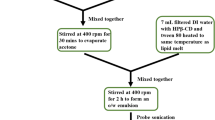Abstract
Stable selenium nanoparticles were synthesized in a sodium carboxymethylcellulose (Na-CMC) solution with a degree of substitution of 0.85 and an average molar weight of 250 000. The shape and size of selenium nanoparticles were determined by dynamic light scattering and UV spectroscopy. It was found that the nanoparticles coated with Na-CMC are stable upon storage for 28 days. A significant prolongation of the release of the prospidine antitumor agent from stabilized nanoparticles has been shown. Broad spectrum drugs, in particular, anticancer drugs and drugs that compensate for selenium deficiency in the body can be produced based on the selenium nanoparticles coated with Na-CMC.






Similar content being viewed by others
REFERENCES
Ibrahim, O.M., El-Deeb, N.M., Abbas, H., Elmasry, S.M., and El-Aassar, M.R., Int. J. Biol. Macromol., 2020, vol. 146, pp. 119–131. https://doi.org/10.1016/j.ijbiomac.2019.12.266
Ganipineni, L.P., Danhier, F., and Préat, V., J. Controlled Release, 2018, vol. 281, pp. 42–57. https://doi.org/10.1016/j.jconrel.2018.05.008
Solomevich, S.O., Bychkovsky, P.M., Yurkshtovich, T.L., Golub, N.V., Mirchuk, P.Y., Revtovich, M.Y., and Shmak, A.I., Carbohydr. Polym., 2019, vol. 226, ID 115308. https://doi.org/10.1016/j.carbpol.2019.115308
Wu, H., Li, X., Liu, W., Chen, T., Li, Y., Zheng, W., Wing-Yin Man, C., Wong, M.-K., and Wong, K.-H., J. Mater. Chem., 2012, vol. 22, pp. 9602–9610. https://doi.org/10.1039/C2JM16828F
Shuang, Li, Fuling, Bian, Ling, Yue, Hua, Jin, Zongguo, Hong, and Guangwen, Shu, Int. J. Biol. Macromol., 2014, vol. 69, pp. 64–72. https://doi.org/10.1016/j.ijbiomac.2014.05.020
Cui, D., Ma, J., Liang, T., Sun, L., Meng, L., Liang, T., and Li, Q., Int. J. Biol. Macromol., 2019, vol. 137, pp. 829–835. https://doi.org/10.1016/j.ijbiomac.2019.07.031
Li, H., Liu, D., Li, S., and Xue, C., Int. J. Biol. Macromol., 2019, vol. 129, pp. 818–826. https://doi.org/10.1016/j.ijbiomac.2019.02.085
Asghari-Paskiabi, F., Imani, M., Razzaghi-Abyaneh, M., and Rafii-Tabar, H., Sci. Iran., 2018, vol. 25, no. 3, pp. 1857–1863. https://doi.org/10.24200/SCI.2018.5301.1192
Tang, S., Wang, T., Jiang, M., Huang, C., Lai, C., Fan, Y., and Yong, Q., Int. J. Biol. Macromol., 2019, vol. 128, pp. 444–451. https://doi.org/10.1016/j.ijbiomac.2019.01.152
Liu, L., Xiao, Z., Niu, S., He, Y., Wang, G., Pei, X., Tao, W., and Wang, M., Mater. Des., 2019, vol. 182, ID 108024. https://doi.org/10.1016/j.matdes.2019.108024
Yurkshtovich, T.L., Golub, N.V., Solomevich, S.O., Kosterova, R.I., Yurkshtovich, N.K., Alinovskaya, V.A., and Bychkovsky, P.M., Colloid, J., 2019, vol. 81, no. 3, pp. 329–336. https://doi.org/10.1134/S1061933X19030165
Haroon, M., Wang, L., Yu, H., Ullah, R.S., Zain-ul-Abdin, Khan, R.U., Chen, Q., and Liu, J., Carbohydr. Polym., 2018, vol. 186, pp. 150–158. https://doi.org/10.1016/j.carbpol.2018.01.052
Yang, X., Shi, X., Dʹarcy, R., Tirelli, N., and Zhai, G., J. Controlled Release, 2018, vol. 272, pp. 114–144. https://doi.org/10.1016/j.jconrel.2017.12.033
Zhang S.-Y., Zhang, J., Wangб H.-Y., and Chen H.-Y., Mater. Lett., 2004, vol. 58, no. 21, pp. 2590–2594. https://doi.org/10.1016/j.matlet.2004.03.031
Solomevich, S.O., Bychkovskii, P.M., Yurkshtovich, T.L., and Golub, N.V., Russ. J. Appl. Chem., 2016, vol. 89, no. 8, pp. 1302–1308. https://doi.org/10.1134/S1070427216080140
Solomevich, S.O., Cherkasova, A.V., Salamevich, D.A., Aharodnikau, U.E., Bychkovsky, P.M., and Yurkshtovich, T.L., Mater. Lett., 2021, vol. 293, ID 129720.
Yurkshtovich, T.L., Solomevich, S.O., Golub, N.V., Alinovskaya, V.A., Kosterova, R.I., Bychkovskii, P.M., and Kladiev, A.A., Colloid J. 2014, vol. 76, no. 5, pp. 628–636. https://doi.org/10.1134/S1061933X14050172
Bartosiak, M., Giersz, J., and Jankowski, K., Microchem. J., 2019, vol. 145, pp. 1169–1175. https://doi.org/10.1016/j.microc.2018.12.024
Scott, R., MacPherson, A., Yates, R.W., Hussain, B., and Dixon, J., Brit. J. Urol., 1998, vol. 82, no. 1, pp. 76–80. https://doi.org/10.1046/j.1464-410x.1998.00683.x
Potapov, A.L., Ivanova, N.A., and Agabekov, V.E., Polimer. materialy i tekhnologii, 2016, vol. 2, no. 3, pp. 24–29.
Rajagopal, G., Nivetha, A., Ilango, S., Muthudevi, G.P., Prabha, I., and Arthimanju, R., J. Environ. Chem. Eng., 2021, vol. 9, no. 4, ID 105483. https://doi.org/10.1016/j.jece.2021.105483.
Hanna, D.H., Lotfy, V.F., Basta, A.H., and Saad, G.R., Int. J. Biol. Macromol., 2020, vol. 150, p. 228. https://doi.org/10.1016/j.ijbiomac.2020.02.056
Funding
This work was financially supported by the project of the Fund for Support of Fundamental Research of the Academy of Sciences of the Republic of Uzbekistan, vol. 1–18 “Revealing the patterns of the formation of selenium nanoparticles in the polymer structure for the creation of original anticancer drugs” and the international project Uzbekistan–Belarus with financial support from the Ministry of Innovative Development of the Republic of Uzbekistan and Ministry of Education of the Republic of Belarus “Creation of polymer forms of drugs for the treatment of oncological diseases based on selenium nanoparticles stabilized on biodegradable polymer substrates of natural origin.”
Author information
Authors and Affiliations
Corresponding author
Ethics declarations
The authors declare that they have no conflicts of interest requiring disclosure in this article.
Additional information
Translated from Zhurnal Prikladnoi Khimii, No. 9, pp. 1186–1194, January, 2021 https://doi.org/10.31857/S0044461821090085
Supplementary information
Rights and permissions
About this article
Cite this article
Yunusov, K.E., Sarymsakov, A.A., Turakulov, F.M. et al. Synthesis of Selenium Nanoparticles Stabilized with Sodium Carboxymethylcellulose for Preparation of a Long-Acting Form of Prospidine. Russ J Appl Chem 94, 1259–1266 (2021). https://doi.org/10.1134/S1070427221090081
Received:
Revised:
Accepted:
Published:
Issue Date:
DOI: https://doi.org/10.1134/S1070427221090081




